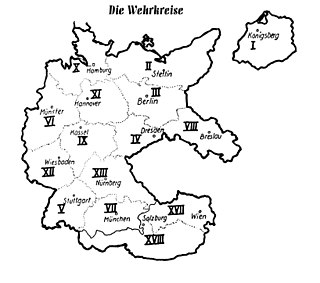Related Research Articles
Army Group North was a German strategic formation, commanding a grouping of field armies during World War II. The German Army Group was subordinated to the Oberkommando des Heeres (OKH), the German army high command, and coordinated the operations of attached separate army corps, reserve formations, rear services and logistics, including the Army Group North Rear Area.

The military districts, also known in some English-language publications by their German name as Wehrkreise, were administrative territorial units in Nazi Germany before and during World War II. The task of military districts was the organization and the handling of reinforcements and resupplies for local military units. The Replacement Army (Ersatzheer) managed the districts. Responsibilities such as training, conscription, supply, and equipment were entrusted to the Ersatzheer.

Army Group H, Army Group Northwest after March 1945, was a German army group in the Netherlands and in Nordrhein-Westfalen during World War II.
The LIII Army Corps was a corps of the German Army during World War II. It was first deployed in 1941 and was active as part of various armies under Army Group Centre until 1944, when it was destroyed during the Soviet Red Army operations Bagration and Kutuzov in June and July 1944. The corps suffered enormous casualties as a result of the Soviet attacks. All of its divisions were destroyed and all but a few of the soldiers were killed or captured by the Soviet Union. A new formation named LIII Army Corps was subsequently deployed in December 1944, when it was assigned to Seventh Army and fought on the western front until surrendering to United States Army forces in April 1945.
The CI Army Corps, alternatively also referred to as Roman 101st Corps, was a corps-level unit of the German Wehrmacht during World War II. It existed only for a few months during the year 1945.
The LXIII Army Corps was an army corps of the German Wehrmacht during World War II. The corps was formed in November 1944.
The LXVI Army Corps, initially known as the LXVI Reserve Corps, was an army corps of the German Wehrmacht during World War II. The corps was formed in September 1942.
The LXVII Army Corps, initially known as the LXVII Reserve Corps, was an army corps of the German Wehrmacht during World War II. The corps was formed in September 1942.
The LXXII Army Corps was an army corps of the German Wehrmacht during World War II. The corps was formed in February 1944. Before October 1944, it carried the designation z. b. V., marking it as a corps 'for special deployment'.
The LXXIV Army Corps was an army corps of the German Wehrmacht during World War II.
The LXXXI Army Corps was an army corps of the German Wehrmacht during World War II. The corps was established in occupied France in 1942 and remained active until 1945.

The LXXXIII Army Corps was an army corps of the German Wehrmacht during World War II. It was formed in 1942 and existed until 1943. After its dissolution, the personnel of the LXXXIII Army Corps was used to form the staff of the new 19th Army.

The LXXXV Army Corps was an army corps of the German Wehrmacht during World War II. The corps existed between 1944 and 1945 and had been preceded by a formation known as Group Knieß between 1943 and 1944.
The LXXXVI Army Corps was an army corps of the German Wehrmacht during World War II. It was formed in 1942 and existed until 1945.

The LXXXVII Army Corps was an army corps of the German Wehrmacht during World War II. It was formed in 1942 and existed until March 1944.

The LXXXVIII Army Corps was an army corps of the German Wehrmacht during World War II. It was formed in 1942 and existed until 1945.
The I Cavalry Corps, initially known simply as the Cavalry Corps, or alternatively as Cavalry Corps Harteneck after its commander, was an army corps of the German Wehrmacht during World War II. It was formed in 1944 and existed until 1945.
The 270th Infantry Division was an infantry division of the German Heer during World War II.
The 544th Volksgrenadier Division was a Volksgrenadier-type infantry division of the German Wehrmacht during World War II. It was active from July 1944 to May 1945. In the first two months of service, the division was designated 544th Grenadier Division.
References
- 1 2 3 4 5 6 Tessin, Georg (1977). Die Waffengattungen - Gesamtübersicht. Verbände und Truppen der deutschen Wehrmacht und Waffen-SS im Zweiten Weltkrieg 1939–1945 (in German). Vol. 1. Osnabrück: Biblio. ISBN 3764810971.
- ↑ Hausleitner, Mariana; et al. (2018). Slowakei, Rumänien, Bulgarien. Die Verfolgung und Ermordung der europäischen Juden durch das nationalsozialistische Deutschland 1933–1945 (in German). Vol. 13. De Gruyter Oldenbourg. ISBN 9783110495201.
- 1 2 Tessin, Georg (1967). Die Landstreitkräfte 006–014. Verbände und Truppen der deutschen Wehrmacht und Waffen-SS im Zweiten Weltkrieg 1939–1945 (in German). Vol. 3. Frankfurt/Main: Verlag E. S. Mittler & Sohn GmbH. ISBN 3764809426.
- ↑ Tessin, Georg (1970). Die Landstreitkräfte 015–030. Verbände und Truppen der deutschen Wehrmacht und Waffen-SS im Zweiten Weltkrieg 1939–1945 (in German). Vol. 4. Frankfurt/Main: Verlag E. S. Mittler & Sohn GmbH. ISBN 3764810831.
- ↑ Lakowski, Richard. "Der Zusammenbruch der deutschen Verteidigung zwischen Ostsee und Karpaten". In Müller, Rolf-Dieter (ed.). Die Militärische Niederwerfung der Wehrmacht (in German). Deutsche Verlags-Anstalt. pp. 491–680.
- ↑ Tessin, Georg (1966). Die Landstreitkräfte 001–005 (in German). Frankfurt/Main: Verlag E. S. Mittler & Sohn GmbH. ISBN 3764808713.